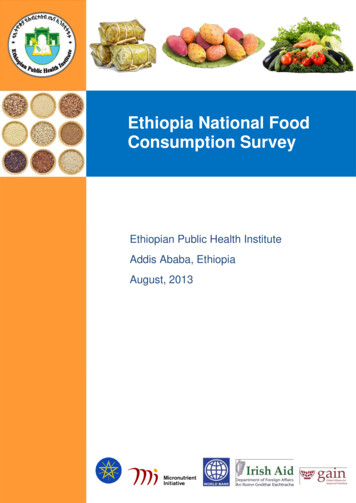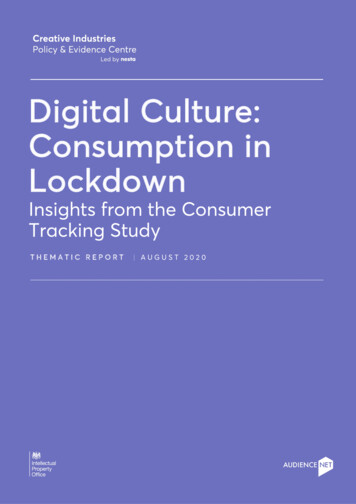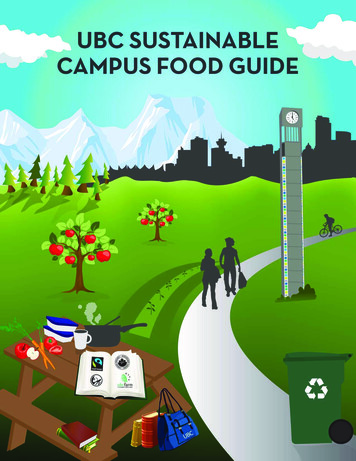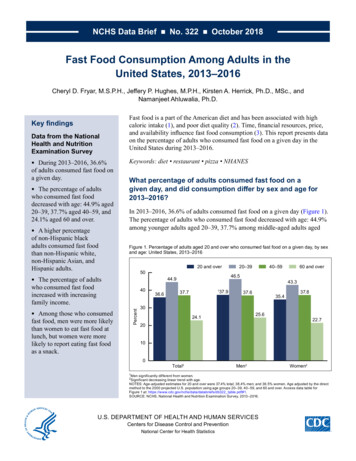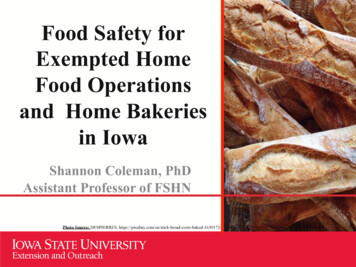
Transcription
Production, Consumption, and Food Security inViet NamDiagnostic OverviewChungmann Kim1, Cristina Alvarez2, Abdul Sattar2, Arkadeep Bandyopadhyay 1, Carlo Azzarri1,Ana Moltedo 2 * , Beliyou Haile11IFPRI2FAOJanuary 7, 2021AbstractIn this report we examine food security, agricultural production, as well as food and nutrient consumptionpatterns of Vietnamese households, drawing on data from the 2016 Viet Nam Household LivingStandards Survey (VHLSS), which is representative at the national, urban/rural, and regional levels.Results show that plant-based calorie production is dominated by just three crops -rice (plain, specialty,and sticky), maize, and cassava- that jointly account for more than 75% of total available calories fromown production. Plain rice is the primary source of available protein, calcium, carbohydrates, iron andzinc from own-produced food, while eggs contribute the most towards Vitamin A and fat availability.Looking at consumption, we find that rice (the most commonly grown crop) is the food item with thehighest consumption (almost 300g per person/day). It is also the only staple crop commonly consumed bynearly all households. The prevalence of undernourishment (SDG indicator 2.1.1) stands at over 11% forthe general population, with a higher PoU found in rural areas (11.9% versus 8.5% in urban areas), and amarked spatial difference by region -South East shows the lowest PoU (8.6%) while Central Highlandsthe highest (15.6%). The prevalence of moderate or severe food insecurity, as measured with the FoodInsecurity Experience Scale (SDG indicator 2.1.2), is 16.1%, whereas the prevalence of severe foodinsecurity is 1.8%. At the national level, daily dietary energy consumption is estimated around 2,507calories per capita, with about 70% of the dietary energy consumed coming from carbohydrates and about17%, and 13% of energy from fats and protein, respectively. These figures are in line with WHOrecommendations for a balanced diet, with adequate contribution of macronutrients to total energy. Ananalysis of the dietary diversity at the household level showed that nearly all households consume cereals,vegetables, flesh meats, eggs, fish and seafood, legumes, nuts and seeds, oils/fats, sweets,spices/condiments and beverages. However, milk and derivates, white roots and tubers and fruits are onlyconsumed by relatively fewer, better-off households with high levels of dietary diversity.As part of the International Dietary Data Expansion Project (INDDEX), this research was jointly prepared by IFPRIand FAO (corresponding author: c.azzarri@cgiar.org), in collaboration with the Gerald J. and Dorothy R. FriedmanSchool of Nutrition Science and Policy at Tufts University. We would like to thank participants of the workshop”Analyzing food consumption data from household surveys to derive food security and nutrition indicators” in Hanoi(March 2019) for helpful contributions and comments on a previous version of the report.*1
Table of ContentsAbstract . 1List of Tables . 4Table of Figures . 6Acronyms. 71.Introduction . 82.Country background. 93.Food and Nutrition Security . 124.Data. 135. Methodology . 145.1 Crop Production . 145.2 Food Composition Tables and Nutrient Requirements. 155.3 Adult Male Equivalent Analysis (AME) . 175.4 Food Away from Home (FAFH) . 185.5 Dietary Energy and Nutrient Consumption . 185.6 Adequacy of Nutrient Consumption . 195.7 Prevalence of Undernourishment (Dietary Energy Inadequacy) . 195.8 Balanced Diet. 205.9 Household Dietary Diversity Score . 215.10 Food Insecurity based on the FIES . 226. Results . 246.1 Nutrient Availability from Crop Production. 256.2 Household Food Consumption . 316.3 Household Dietary Diversity Score . 482
6.4 Food Insecurity based on the FIES . 53Conclusions. 55References . 58Appendices . 62Appendix A. Sampling design of the 2016 VHLSS . 62Appendix B. Estimated Average Requirements used in the analysis . 63Appendix C. Extended description of the methodology used to assess the Prevalence ofUndernourishment (Dietary Energy Inadequacy) . 64Dietary energy requirements. 65Coefficient of variation. 67Appendix D. Predictive Equations for Estimating Minimum Dietary Energy Requirement(MDER) . 68Appendix E. FIES Survey module. 70Appendix F. FIES: Key concepts and methods . 71Statistical validation and parameter estimation . 71Computation of SDG indicator 2.1.2 . 72Appendix G. FIES: Results of the validation and calibration analysis . 743
List of TablesTable 1 Characteristics of the households sampled in the VHLSS 2016 . 25Table 2 Most commonly own-produced plant and animal source foods. 25Table 3 Nutrient availability from most commonly own-produced plant and animal source foods(per AME/day) . 28Table 4 Cereal and legume production (past 12 months, by region) . 30Table 5 Nutrient availability own production by socioeconomic variables (AME per day). 30Table 6 Most commonly consumed food items . 32Table 7 Top ten contributors to dietary energy consumption. 33Table 8 Top ten contributors to protein consumption . 34Table 9 Top ten contributors to calcium consumption at national level . 35Table 10 Top ten contributors to iron consumption at national level. . 35Table 11 Top ten contributors to zinc consumption . 36Table 12 Top ten contributors to vitamin A consumption (in RAE) . 36Table 13 Average dietary energy and macronutrient consumption . 37Table 14 Prevalence of undernourishment (PoU) by selected socioeconomic variables. 39Table 15 Percentage of the population having access to a balanced diet by region . 41Table 16 Average calcium consumption (mg/capita/day) by selected socioeconomic variables. 43Table 17 Average zinc consumption (mg/capita/day) by selected socioeconomic variables . 44Table 18 Average vitamin A consumption by selected socioeconomic variables . 47Table 19 HCES-Diet Diversity Score, associated total dietary energy consumption, and dietaryenergy provided by the food items in the HCES-DDS . 49Table 20 Percentage of individuals living in households with access to a particular food group byhousehold dietary diversity tercile and region . 504
Table 21 Food groups consumed by more than 50 percent of individuals in the different HCESDDS terciles at national level. . 52Table 22 Average prevalence rates (%) of food insecurity in the total population and amongadults in Viet Nam, 2014-16 and 2015-2017 . 53Table 23 Sub regional and global prevalence rates (%) of food insecurity in the total population,2014-16 and 2015-2017 . 53Table 24 Estimated severity parameters for the FIES items and corresponding infit statistics . 74Table 25 Estimated severity parameters for each raw score based on data collected in Viet Namin 2014, 2015, 2016 and 2017 . 75Table 26 Weighted proportion of cases for each raw score in Viet Nam in 2014, 2015, 2016 and2017. 765
Table of FiguresFigure 1 Spatial variation in dietary energy availability from production (AME). 29Figure 2 Spatial variation in dietary energy consumption and PoU by region . 39Figure 3 Spatial variation in average calcium consumption and ratio of consumption torequirement . 44Figure 4 Spatial variation in average zinc consumption and ratio of consumption to requirement(considering a mixed/refined diet, and unrefined diet). 46Figure 5 Spatial variation in average vitamin A consumption (mcg of RAE) and ratio ofconsumption to requirement. 48Figure 6 FIES scale estimated in Viet Nam using 2014, 2016 and 2017 data, against the globalstandard, after adjustment . 766
ISDGTEEUSDAAverage Dietary Energy RequirementsAdult Male EquivalentAnimal-Source FoodsBody Mass IndexCentral Intelligence AgencyConsumer Price IndexDietary Energy ConsumptionDietary Energy RequirementsEstimated Average RequirementsFood Away from HomeFood and Agriculture Organization of the United NationsFood Composition TableFood Insecurity Experience ScaleHousehold Consumption and Expenditure SurveysHousehold Dietary Diversity ScoreInternational Food Policy Research InstituteInternational Dietary Data Expansion ProjectUnited States Institute of MedicineInfant and Young Child Feeding PracticesLiving Standards Measurement StudyMinimum Dietary Energy RequirementPhysical Activity LevelPrevalence of UndernourishmentPurchasing Power ParityRetinol Activity EquivalentsRetinol EquivalentsRecommended Nutrient IntakesSustainable Development GoalTotal Energy ExpenditureUnited States Department of Agriculture7
1. IntroductionIn recent decades, there has been an increase in quality and quantity of HouseholdConsumption and Expenditure Surveys (HCES) as well as analytical rigor in their use fornutritional analysis (Zezza et al. 2017; Russell et al. 2018). Within the realm of individual dietaryintake surveys, direct weighing of food items is considered the gold standard to obtainreasonably accurate estimates of food quantities consumed, with the 24-hour recall method 1 asthe second-best approach, preferable to longer recall periods in terms of reduced recall bias andmeasurement error to assess dietary intake (Biro et al. 2002). Food frequency questionnaires canassess usual diet by relying on longer recall periods-typically 7-30 days. However, individualdietary intake surveys are not commonly conducted at the scale and frequency required to informand monitor national policies owing to their operational costs and logistical challenges (Fiedleret al. 2012; Gibson et al. 2012).HCES are typically collected as part of the national data collection system, and often boastlarge sample sizes, which allow sub-national representativeness (Fiedler et al. 2012). Literaturehas also shown general consistency between estimates derived from HCES on one side andindividual 24-hour recalls on the other, both in the type and quantity of foods consumed (Lambeet al. 1998; Naska, Vasdekis, and Trichopoulou 2001; Friel et al. 2001; Jariseta et al. 2012) aswell as apparent nutrient consumption (Naska et al. 2007; Nelson, Dyson, and Paul 1985). 2Nevertheless, HCES food consumption data collection based on 7-day recall often suffer fromrecall bias and, in turn, underreporting, especially among households with vulnerable membersincluding elderly, women, and low-educated (Backiny-Yetna, Steele, and Yacoubou Djima 2017;Beegle et al. 2012). Moreover, they do not allow for calculation of sex-age dissagregatedThe international standard approach uses the multiple pass 24HR technique in which the respondent recalls foodsand beverages consumed – and their quantities – in the past 24 hours. See definition ta-source/24-hour-dietary-recall-24hr.2Food consumption indicators computed from household level data are usually labelled “apparent consumption” —expressed in terms of dietary energy, macro- and micro-nutrients, because they are based on food quantities (edibleamounts) available for consumption, not on actual intake, and in most cases they refer to the raw form beforepreparation. However, in this report we use the term “consumption” to simplify terminology.18
indicators and identification of the most vulnerable groups. Indeed, the best tool to assessindividual-level consumption are individual dietary intake surveys such as 24hr recalls.This study adds to a body of literature showing the usefulness of HCES for food security andnutrition analysis (Fiedler et al. 2012). We use available data for Viet Nam to identify majorsources of dietary energy and nutrients from both production and consumption survey modules.We aim to address the following questions:1. What are the regional patterns of food production and consumption in Viet Nam?2. What are the potential energy and nutrient availability compared to caloric and nutrientconsumption? Are the latter adequate for an active and healthy life?3. How do food production and consumption differ by geographic and socio-economicfactors?Trying to address question #1 will provide us with an idea of the areas where households aremore likely to be net sellers rather than net buyers of food commodities, Question #2 will divedeeper into the potential nutrients (both macro- and micro-) available from production, comparedto the energy and nutrient requirements for the population. Finally, question #3 will try to shedlight on heterogeneity and possible geographic targeting of food security and nutrition policyinterventions.2. Country backgroundSince the enactment of Viet Nam's "Doi Moi" 3 (renovation) policy in 1986, Vietnameseauthorities have committed to increased economic liberalization and enacted structural reformsneeded to modernize the economy and produce more competitive, export-driven industries (CIA2016). Viet Nam has accomplished momentous progress in poverty reduction since the marketreform. The share of the population living below the international poverty line of 5.50 percapita/day at 2011 Purchasing Power Parity (PPP) 4 has been brought down to 8.8% in 2016 fromDoi Moi literally means ‘economic renovation’. It is the name given to the set of economic reforms initiated in VietNam in 1986 with the goal of creating a ‘socialist-oriented market economy’.4The PPP relies on construction of an adjusted exchange rate for each country that equalizes the nominal exchange39
13.4% in 2014 (World Bank 2018). The unemployment rate in Viet Nam is currently 2.2%,which is one of the lowest in the world (World Bank 2018).However, despite remarkable achievements in reducing poverty, Viet Nam still faces incomeand other socioeconomic disparities, particularly for ethnic minorities and other vulnerablegroups (ADB 2018). Significant social barriers exist for women : they accounted for only 18.3%of party leadership at the commune level, 14.2% at the district level, and 11.3% at the municipallevel in 2014 (Bertelsmann Stiftung 2018). The poverty rate among ethnic minorities, most ofwhom live in mountainous and remote areas, is nearly 60%, almost ten times higher than that forthe Kinh (the ethnicity of majority Vietnamese) (Bertelsmann Stiftung 2018). However, from ourdata, the national Gini coefficient for nominal food expenditure is 0.345, signalling relativelylow food expenditure inequality.Viet Nam is divided into the highlands and the Red River Delta in the north, and the CentralMountains, the coastal lowlands in the central region and the Mekong River Delta in the south.There is a drop in elevation from the northwest to the southeast, following the flows of the majorrivers. The two largest rivers, the Red River and Mekong River flow in the northern and southernregions respectively, and they provide soils and nutrients for agricultural land. Arable landhowever is limited, with only 20% of the total land able to support agriculture. Climate is diverseas well, with three broad regions. Conditions are humid and subtropical in the north, tropicalmonsoon in the centre, and tropical savannah in the south. High levels of humidity prevailthrough the year, ranging between 84 and 100 per cent. Mean temperatures range between 21and 27 degrees Celsius and are higher in the southern parts of the country. Soils are quite diversein the country, spanning 14 groups and 31 soil units. The three main soil groups aremountainous, hilly, and delta soils. Mountainous and hilly soils tend to be acidic, degradequickly, and exhibit poor fertility. In contrast, the soils in deltas are primarily alluvial, highlyfertile, and are suited for extensive cultivation (Babatunde Abidoye et al. 2016).The agricultural sector is one of the key contributors to the Vietnamese economy. Itrepresents approximately 15 % of value-added on total Vietnamese gross domestic productrate in terms of the local cost of a common basket of goods and services.10
(GDP) in 2017, higher than countries such as the Philippines (9.6%) and Indonesia (13.9%), butless than Cambodia (48.7%) according to the World Bank data. In absolute terms and constant2010 USD, the total value added to GDP from agriculture, forestry and fishing has increasedfrom 10 billion in 1990 to 26 billion in 2017, in line with economic growth (World Bank2018). There were an estimated 23.5 million smallholder farmers (41%) among 57.4 millionpeople in the labour force in 2017, higher than neighbouring countries: the Philippines (25.4%)and Indonesia (32%) (CIA 2016).Key agricultural production includes rice, maize, coffee, rubber, tea, pepper, soybeans,cashews, sugar cane, peanuts, bananas, pork and poultry (CIA 2016). Sixty-five percent of thepopulation lives in rural areas, with the agricultural sector employing 15% of the entire country’sworkforce (CIA 2016). Though the rural population has decreased from 80% in 1990, thepercentage is still higher than the Philippines (53%) or Indonesia (61%) (World Bank 2018). Dueto agricultural intensification and expansion, the cropped areas have expanded from 7.3 millionha in 1995 to 8.9 million ha in 2014 (GSO 2016). Agricultural land accounts for 34.8%, of which20.6% arable land, 12.1% permanent crops, and 2.1% permanent pasture (CIA 2016). Cerealyield has been steadily increasing for last decades, but it has declined slightly in recent years; in2016 productivity stood at 5,448 kg /ha compared to 5,601 kg/ha in 2015 (World Bank 2018).Rice, maize, and coffee are among the most important crops with respect to rural incomes,employment, and social and environmental impacts; commercial rice production is mainlyconcentrated in the Mekong Delta (MKD) region, maize in the northern mountainous region, andcoffee in the Central Highland (CH) region (World Bank 2016). In 2014, around 7.8 million haof land were devoted to harvesting rice, and MKD is the main rice-producing region in VietNam, critical to both food security and rice exports (World Bank 2016). The annual value of riceexports is around 3 billion, which is about 20 percent of total agricultural exports (World Bank2016). In case of maize, the cultivated area and production were about 1.2 million ha and 5.2million tons, respectively in 2014 (GSO 2016). The fisheries and livestock sectors haveexpanded, and the forestry and cropping sectors have contracted, although all have grown inabsolute terms (Luu Ngoc 2017).11
Viet Nam is confronting several difficult issues, including floods, droughts and pest anddisease outbreaks, which all occur quite frequently (Luu Ngoc 2017). Environmental problemssuch as soil pollution generally come from excessive fertilizer application and pesticide residues(World Bank 2016). The policy in Viet Nam’s agricultural sector has led to non-trivial changesin crop production systems since 1960. While a traditional way of crop production dominatedbefore 1960, significant investments in irrigation systems and rural infrastructure were madeduring 1990-2000s (World Bank 2016). Agricultural investments in intensification have occurredfrom 2001 through 2010, while only recently the government has started placing greateremphasis on sustainability of agriculture (World Bank 2016).3. Food and Nutrition SecurityOf the total population of 96.2 million people in Viet Nam, 10.8% were undernourished inthe period 2015-2017 (FAO et al. 2018). This is a substantial improvement, as the figure stood at18.2% in the period 2004-2006 (FAO et al. 2018). Dietary diversity has also considerablyincreased over the past decade: the share of cereal consumption (in terms of quantity) hasdecreased, while the shares of meat, fish, dairy and eggs have increased, and while the share offruits and vegetables has remained constant (Trinh Thi, Simioni, and Thomas-Agnan 2018). OfViet Nam’s total k-calories food consumption, 58.1% are from grains and roots/tubers, 2.6%from vegetable oil, 15.3% from meat, 3.3% from sugar and sweeteners, and from fruits andvegetables 6.6% (USDA 2017).Moreover, in terms of macronutrients, from 2004 to 2014, the share obtained from fat in totalcalorie intake has increased by 37.5% among Vietnamese rural households, at the expense ofcalories obtained from carbohydrates, calories obtained from proteins staying stable (Trinh Thi,Simioni, and Thomas-Agnan 2018). The nutrition transition to energy dense, poor quality dietshas led to obesity and non-communicable diseases (Trinh Thi, Simioni, and Thomas-Agnan2018). 2.1% of the adult population was obese in 2016, compared to 1.5% in 2012 (FAO et al2018). Furthermore, the stunting rate was 24.6%, and wasting was 6.4% (among children belowthe age of 5), in 2017 (FAO et al 2018). The coexistence of under- and over-nutrition is a12
growing concern for early childhood development (Trinh Thi, Simioni, and Thomas-Agnan2018).It has been reported that an estimated 27% of mothers with children less than five suffer fromchronic energy deficiency (FAO et al 2018). Viet Nam has one of the lowest levels ofbreastfeeding in Southeast Asia, with only 24 percent of children under 6 months being breastfeddespite 95.8 percent of pregnant women receiving prenatal care (World Bank 2018).The ‘‘National Nutrition Strategy for 2011–2020, with a vision toward 2030,” defines themain objectives and instruments of the nutrition policy in Viet Nam (Ministry of Health 2012).Among other goals, it aims to simultaneously reduce the proportion of households with lowcalorie intake (below 1800 kcal) to 5% and reach a proportion of households with a balanceddiet (Protein: 14%; Lipid: 18%; Carbohydrate: 68%) equal to 75% by 2020 (Trinh Thi, Simioni,and Thomas-Agnan 2018). It also proposed to develop specific food and nutrition interventionsto improve the nutritional status of target groups, and therefore, to give priority to the at risk,poor, disadvantaged and ethnic minority areas (Trinh Thi, Simioni, and Thomas-Agnan 2018).Since rice farming is the main livelihood of rural people, the government always gives itshighest priority to maintaining the rice area to ensure food security for the country. Maize is thesecond most important food crop with regards to harvested area, production, and rurallivelihoods, especially in mountainous areas, and it is regarded as an important crop in hungerelimination and poverty reduction programs (World Bank 2016).4. DataThe present study mainly uses the 2016 Viet Nam Household Living Standards Survey(VHLSS), conducted nationwide through two types of samples. The full sample has a samplesize of 46,995 households in 3,133 communes/wards which are representative at national,regional, urban, rural and provincial levels (63 provinces) (GSO 2016); and provides incomerelated information. Household expenditure and consumption information were collected on asub-sample of 9,399 households, representative of the six regions. Given the consumption focusand the purposes of this report, we analysed data from the sub-sample. The sample was designed13
to represent the entire country, regions, and provinces; while commune is the primary samplingunit (ISM and Sinfonica 2015).The survey collected information during four periods, from the first quarter to the fourthquarter in 2016 through face-to-face interviews conducted by interviewers among householdheads and key commune officials in communes containing sample enumeration areas (GSO2016). Food consumption at the household level was collected using a 30-day recall module onfood expenditure including 67 food items.Data used to estimate the prevalence rates of food insecurity, based on the Food InsecurityExperience Scale (FIES) presented in this report, were collected by Gallup Inc. on behalf of FAOthrough the Gallup World Poll, an annual survey of the adult population (defined as individualsaged 15 years and older), conducted in over 140 countries since 2005. Each year, a differentsample of about 1000 individuals is selected, based on the most recent available populationframe. Samples are drawn according to a complex survey design to be proportional to thepopulation in each stratum. Post-stratification weights are provided to extrapolate the results tothe national reference population. FIES data have been collected each year from 2014 to 2017.The datasets have been used to estimate three–year average of prevalence of food insecurity inViet Nam in 2014-16 and 2015-2017. The 2018 VHLSS also included a FIES modulerepresentative at the national and sub-national level, however this information was not availableat the time of writing.5. Methodology5.1 Crop ProductionFor the crop production analysis, we first determined the edible portion and nutrient contentof food crops harvested by survey households during the reference season using informationfrom the Vietnamese FCT (National Institute of Nutrition 2007). This information was thenlinked with self-reported data on the quantity of crops harvested by sampled households(majorities in k
Jan 07, 2021 · Production, Consumption ,and Food Security in . Viet Nam . Diagnostic Overview . Chungmann Kim 1, Cristina Alvarez 2, Abdul Sattar 2, 1Arkadeep Bandyopadhyay , Carlo Azzarri , Ana Moltedo 2 *, Beliyou Haile. 1. 1. IFPRI. 2. FAO. January 7, 2021 . Abstract In this report we examine food security, agricult



